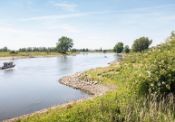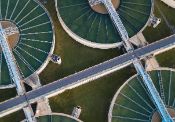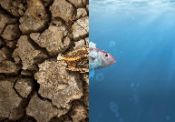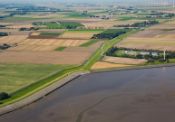We choose a #watertransition! The Netherlands – land of water 2.0

We choose a #watertransition! The Netherlands – land of water 2.0
Look outside and it is easy to forget that it is summer: rain, rain and more rain. While past summers saw extreme drought and heat, this year has been unequivocally wet, with South Limburg, Germany and Belgium being hit by severe flooding. The conditions were unprecedented. Precipitation statistics released by STOWA show that the amount of rain that fell in South Limburg in two days happens just once every 1,000 years. Due to climate change, this will become once every 100 years in the future. But despite this year's heavy rainfall, groundwater levels have not yet recovered from the extreme droughts of 2018, 2019 and 2020. Even the most obstinate climate-change deniers can no longer pretend it is not happening. A profound change is underway; we can feel it, and we can see it. To ensure that our beautiful country remains liveable and is ready for the future, we need a fundamentally different approach to how we interact with our soil-and-water system. We need a #watertransition to adapt to more extreme conditions and to offer perspective for both the short and long term.
New: the webinar booklet
Want to read the recaps and conclusions of the Robust Water Systems webinar series? Then read this webinar booklet, which summarises the key messages from the different topics and provides a clear roadmap for the water transition!
---------
The first step towards a new perspective is to be aware of, but also to appreciate, where we have come from – and to understand how we got here. Everyone in the Netherlands knows the story of how we grew up with 'poldering' and our ‘fight against the water’. We reclaimed land for agriculture, industry and commerce. We dug peat, drained the land, and straightened the waterways. We built the Delta Works and held back the sea and the brute force of nature. And we saw our prosperity rise and our health improve in the process. But there was also a downside to our industriousness: in our quest for control and development, we forgot the natural values of the water system and shot ourselves in the foot. We dug up and burned peat which naturally retains and 'provides' water for agriculture and other uses during dry periods. We blocked rivers for the sake of water safety, reducing biodiversity as well as causing the disappearance of our own food, such as eels. To this day, we keep the water level artificially low, causing subsidence in peaty areas. We drain our precious water into the sea as quickly as we can. We are building in vulnerable places, such as in river valleys and in low-lying areas, and we are structurally hardening our land, which contributes to flooding. Quite simply, we have ignored the value and attributes of the natural water system. As a result, the design and management of the water system have reached their limits, exacerbated by the extremes of drought and heavy rainfall that are now becoming more common as a result of climate change.
So, to make sure we can keep living in our country, we need to work together to find a new perspective – one with which we can repair the mistakes of the past and recognise the value of the natural water system and use it as a starting point. But we also mustn’t ignore the ingenious technology that got us where we are today. We need to move towards ‘The Netherlands – land of water 2.0’.
What that will look like is something we will have to discover together. But one thing is certain: we need to change the way we design, use, manage and collaborate. We need a water transition that puts the landscape back in the spotlight and makes room for water and nature – a transition in which clean and healthy water is no longer taken for granted, but rather cherished. Where water is captured where it falls, groundwater is replenished and (re)used as reservoirs, water draining is slowed down, and flood-prone areas (river valleys, etc.) are no longer used for housing development. Where urban areas are ‘softened’, water levels dictate function, soil vitality is given a boost, and cycles are closed in a sustainable, responsible and affordable way. We will also need to work hard together to slow the pace of climate change, including by reducing emissions and sequestering greenhouse gases.
We believe that three pillars are key to managing this transition in the short term: understanding the idea of the natural system as a basis, a holistic approach to challenges and working together with courage and determination.
To be able to fix the system and gain a new perspective, you first need to understand how it works. The factual basis of a systems analysis is the bedrock of good collaboration. And everyone needs to have the same factual basis in order to agree, but also to make the right decisions together. Challenges shouldn’t be considered in isolation. Holistic, area-based systems analyses help to identify problems and gain insights into relationships and how the soil-and-water system can be made robuster and better adapted to the region and location. Systems analyses also help us understand the costs and benefits of promising scenarios, both in the short and long term. This gives future generations a voice.
In The Netherlands – land of water: 2.0, we will do this in partnership with stakeholders in the area, working towards a new form of collaboration: Poldering 2.0. A shared factual basis is the starting point for making the right considerations and (political) decisions, but it is also essential for garnering support, so that things actually start to change in the area. In the end, it is not facts that bring about change, but rather people. For The Netherlands – land of water: 2.0 to succeed, we will need to connect with each other. Only by listening to each other with compassion will we be able to gain new insights and overcome existing barriers (in our community, social and economic systems). And this is essential if we are to achieve results not only on paper but also 'in the field'.
We need cross-boundary collaboration – across national borders, between all sectors, and at all levels (both bottom-up and top-down): from nature organisations, the national government, water authorities, municipalities, provinces and non-governmental organisations to industry, the financial and insurance sectors, agriculture, and private individuals. We also need innovation – for example, to reduce water consumption in industry and make the transition towards a circular society a reality.
And we need our politicians to step up to the plate and guide the Netherlands towards becoming a water-robust country. A good vision for spatial planning in the Netherlands is needed to make the #watertransition a success, but also to address the water transition in conjunction with other pressing challenges such as housing, the biodiversity crisis (including the nitrogen issue) and climate change. As talks regarding the formation of the new government are still underway, we hereby call on all participants to include the following six points in the discussions:
- Look at the major challenges we face today (water transition, energy transition, housing, biodiversity crisis, and sustaining prosperity) collectively and make choices. Not everything has to be done everywhere.
- Set the right course at national level by developing a good long-term vision. Provide clear frameworks. Focus much more on the benefits. Establish a Ministry of Housing, Spatial Planning and the Environment 2.0 to oversee spatial planning. This will consolidate responsibility and resources.
- Leave some room for the regions to develop customised solutions (within clear frameworks).
- Let specific soil-and-water systems, with all its values, inform spatial decisions: take soil and water into account and base your decisions on a solid factual basis.
- Allocate functions in the right areas; the natural soil and water system should dictate what the land is used for.
- Instead of reckoning and accountability, inspire confidence, dare to deal with uncertainty and create space for new solutions.
Finally, it is all too easy to leave everything to the politicians. We all have a part to play. The transition starts with us. Do you dare to venture off the beaten track and create a win-win-win situation for you, your partner and the water system? Start small, think big! Let's do it together!
Watch or read more?
This spring, Witteveen+Bos organised a ten-part webinar series that looked in more detail at where the problems lie, exploring different perspectives and solutions for the #watertransition. The webinars were recorded and are now available to watch. We have also produced an inspiring booklet on the series, featuring convincing examples. And finally, every two months we publish a blog post featuring an interview with an influential professional sharing their vision on the #watertransition. So, there’s plenty to think about. Now let’s get to work!
Questions, suggestions and/or comments?
Do you have any questions, suggestions and/or comments about this blog post or on the #watertransition in general? Or do you have ideas for a cross-boundary collaboration? Then contact Marloes van der Kamp (marloes.van.der.Kamp@witteveenbos.com) or Sebastiaan Schep (Sebastiaan.schep@witteveenbos.com).
More information about the authors
This blog post was compiled in collaboration with experts from various disciplines: soil (Corinne Koot), water (Ebbing van Tuinen, Jaap Klein, Ingrid van den Brink & Inge Phernambucq), ecology (Remco van Ek & Daan van Wieringen), water quality (Marloes van der Kamp & Sebastiaan Schep), climate change adaptation (Matthias Hoendermis), circularity (Arjen van Nieuwenhuijzen) and zoning processes (Jacqueline Bulsink & Michiel Voskamp).









